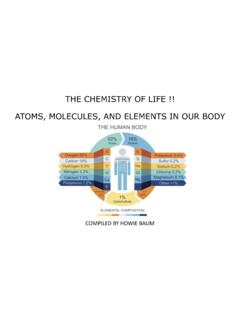Transcription of Essential Oils from Steam Distillation
1 Biorenewables Education Laboratory Essential oils Summer Academy Student Guide JB/CB 2011 1 Essential oils from Steam Distillation Learning Objectives: Enhance participant understanding of plant organic chemistry . Enhance participant understanding of high-value uses for biomass. Provide opportunity for participants to gain hands-on experience with Steam Distillation equipment and Essential oils . Learning Outcomes: Upon completion of this lab, participants will be able to: Explain the difference between primary and secondary plant metabolites.
2 List examples of secondary metabolites, terpenes and terpenoids. Describe secondary metabolite extraction methods. Extract Essential oils from biomass using Steam Distillation equipment. Pre-Lab Background Secondary Metabolites The primary goal of plants, like all organisms, is to grow and reproduce. Most of the metabolites produced by plants, therefore, are polysaccharides and proteins that give the plants structure and function. Plants also produce very small amounts of secondary metabolites: compounds that are not directly related to growth or reproduction. Many of these secondary metabolites are very commercially valuable and some have very complex chemistry .
3 Most of the plant compounds used in perfumes, flavors, and natural medicines are secondary metabolites. Terpenes and Terpenoids One of the key secondary metabolite building blocks is a five carbon molecule called isoprene (or, more officially, 2-methyl-1,3-butadiene). Isoprene is used by plants to produce terpenes, molecules made from 2 or more isoprenes, and terpenoids, terpenes that have slight chemical modifications, especially terpene alcohols. Terpenes and terpenoids are the chemical compounds responsible for many plant smells and flavors. Pine trees produce a large number of terpenes and the solvent turpentine was originally derived from pine tree resin.
4 Biorenewables Education Laboratory Essential oils Summer Academy Student Guide JB/CB 2011 2 D-limonene farnesol retinol Terpenes may be classified by the number of isoprene units in the molecule. Monoterpenes consist of two isoprene units and have the molecular formula C10H16. Limonene, the smell of citrus, is a monoterpene. Sesquiterpenes consist of three isoprene units and have the molecular formula C15H24. Farnesol, is an alcohol sesquiterpenoid that is responsible for floral smells like roses.
5 Diterpenes consist of four isoprene units and are precursors for many important biological molecules with anti-inflammatory, antimicrobial and anti-cancer properties. Retinol, aka Vitamin A, is a diterpenoid. Triterpenes consist of six isoprene units. Squalene is a triterpene that organisms use to make cycloartenol, the precursor to steroids. Tetraterpenes contain eight isoprene units and include antioxidants lycopene and beta-carotene. Polyterpenes are even longer chains of isoprene units. Natural rubber is a polyterpene. Extraction Methods Since plants only make small amounts of secondary metabolites, a great deal of plant material is needed to produce a useable amount of a certain product.
6 Over millennia, people have developed several methods to extract and concentrate desired compounds from plants. One well-known example is hot-water extraction used to make coffee, teas, and soup stocks. Solvents such as alcohol can also be used such as to make liquid extracts used in food flavorings and perfumes. Cold-pressing with fats and waxes can be used for compounds sensitive to heat such as jasmine. The best extraction method to use depends on the volatility (ease of evaporating) and polarity (hydrophilicity or hydrophobicity) of the desired compounds. Steam Distillation , the method used in this lab for Essential oil extraction, takes advantage of the volatility of a compound to evaporate when heated with Steam and the hydrophobicity of the compound to separate into an oil phase during condensation.
7 Essential oils Essential oils are the collection of hydrophobic secondary metabolites that can be extracted from plants and are used in perfumes, flavorings and alternative medicine techniques such as aromatherapy. While a single compound may have a distinct smell, most Essential oils are actually hundreds of compounds that, when combined, create the smell associated with that particular plant. Below are some examples of compounds found in many Essential oils in various concentrations. Biorenewables Education Laboratory Essential oils Summer Academy Student Guide JB/CB 2011 3 methyl butyrate benzaldehyde cinnamaldehyde methone Methyl butyrate is the fruity smell of apples and pineapple.
8 Benzaldehyde is associated with almonds. Cinnamaldehyde, as the name implies, is the smell of cinnamon. Methone is one of several compounds associated with minty smells. R-carvone S-carvone pinene anethone The R and S entiatiomers of carvone are associated with the smell of spearmint and caraway, respectively. Pinene is the smell of pine and rosemary. Anethole is responsible for the distinctive smell of anise and black licorice. Pre-Lab Tasks 1. Brainstorm reasons why secondary metabolites are generally higher-value products from biomass than primary metabolites, especially polysaccharides.
9 2. Choose a biomass from the list in the background section of the lab procedure and find at least one of the chemical structures responsible for the smell/flavor (not including the ones listed above). 3. List and describe biomass extraction method you use on a daily or monthly basis. What kind of products are you obtaining from biomass? 4. Many of the earliest synthetically produced pharmaceuticals were based on plant products. Research and summarize the discovery of aspirin. What are some other drugs do we have that are based on plant molecules? 5. Make up and draw your own sesquiterpene or diterpene.
10 Describe the bonds you chose to use. Use that molecule to draw a related terpenoid. Biorenewables Education Laboratory Essential oils Summer Academy Student Guide JB/CB 2011 4 Steam Distillation of Biomass Safety Checklist o Proper attire is worn (long pants and closed-toe shoes). o Food and drinks are stored and consumed outside the laboratory. o Lab coat and safety glass are worn. o Latex or nitrile gloves are used when handling samples and chemicals. o Insulated gloves are used when handling hot materials.













